This post was kindly written by Dave Sheldon, a frequent contributor to climbing magazines, and an awesome bodyworker. You can see his full bio below.
Enter Dave Sheldon:
Lightweight belayers – or those who climb with people who outweigh them by twenty-five pounds or more – routinely get yanked off the ground when catching leader falls.
Although this phenomenon can be a bit disconcerting at first, all it takes is a little forethought to keep the belayer and the falling climber smiling and trauma free.
Here are 7 tips for how to belay a sport pitch when the climber outweighs the belayer:
1. When belaying, stand under the first bolt that will be clipped by the leader.
Should the leader fall, this position ensures that the belayer will be lifted straight upward off their feet, not dragged across the ground and scraped along the side of the cliff.
2. Consider having the leader reach down and unclip the first bolt after clipping the second bolt; this will prevent the belayer from being yanked up into the first quickdraw.
Many times an extra-long stick clip can be used to bypass the first bolt entirely, thus eliminating the downclimbing and unclipping shenanigans.
3. Scan the rock under the first bolt or two and examine the likely path of upward trajectory.
Are there any rock spikes or nasty ledges to be wary of? Or, is the wall smooth and forgiving? If the opening terrain is overhanging, it’s possible the belayer will get pulled up into the air, never even touching rock.
4. Wear sturdy, closed-toed shoes to protect feet and ankles from scrapes and sprains.
Flip-flop sandals are not allowed! Remember, as the belayer zips upward, both of her hands will be occupied with the job of belaying, so, it’s her feet that will keep her body away from the rock.
5. Wear gloves and, if you’re not too cool, a helmet.
Having to deal with the worst- case scenario of rope-burned hands or a bonked head while dangling five to fifteen feet in the air is disorienting and puts both the climber and belayer at great risk.
6. When the leader pitches off, the belayer will want to hold on tight and prepare for liftoff.
The belayer should not jump! The leader will be guaranteed a soft catch simply due to the weight discrepancy. It can even be a good idea for the belayer to lean down on one knee if the leader might fall onto the second bolt. Kneeling can increase the distance between belayer and leader by a foot or two, which might just be the span needed to prevent climber and belayer from knocking into each other while one is going up and the other coming down.
7. Communicate!
When the leader falls, he yells, “falling!” This prevents the belayer from being surprised. The leader should also share when a fall seems like a distinct possibility. Calling out, “Watch me!” works well.
About The Author – Dave Sheldon
 Dave has been climbing for sixteen years and has climbed sport routes up to 5.13b. He enjoys writing about what makes top climbers tick and how the 99% can more efficiently achieve their climbing goals in a creative, safe, and injury free manner.
Dave has been climbing for sixteen years and has climbed sport routes up to 5.13b. He enjoys writing about what makes top climbers tick and how the 99% can more efficiently achieve their climbing goals in a creative, safe, and injury free manner.
When he’s not burning valuable resources commuting to Rifle Mountain Park, he works as an Advanced Rolfer and SourcePoint Therapist in Boulder, CO. Neely is one of his highly satisfied clients, actually! Visit his website for more information about his private practice. www.davesheldon.com







Hi any tips for this scenario? The other day I was belaying a friend on an indoor sport route. I stayed close the wall as he is heavier than me. He pulled up the rope to clip the third draw and I let out slack to allow him to do it. Before he could actually clip he fell. Because of the slack in the rope and the weight ratio he hit the deck and I went up. Had I realised he was going to fall I maybe could have ran backwards to take out the slack but I’m not sure I would have had enough time or if it would have even worked because of the weight difference. Is there anything I could have done to prevent this happening?
Thanks
Emma
Hey Emma – That’s a shitty situation, and I’ve definitely come close to having that happen as a small person myself. I haven’t used this device myself, but the Edelrid Ohm was created for exactly this scenario: http://www.edelrid.de/en/ohm/
I think your climber places it on the first draw and it creates friction when they fall (but apparently not otherwise). The other thing you can do is attach a sandbag to your harness when you’re belaying someone much bigger than you – most gyms offer them now. I’ve also put backpacks with heavy stuff in them on while belaying (inside and outside), or you could wear a weight vest (much more comfortable than the backpack!). I hope those suggestions help!
Any tips for vert or slab with a much heavier leader? Would an anchor be more appropriate in these situations? Thanks.
Any tips on vertical routes or even slab?
Good advice! The only thing I would add is to have a plan if it’s an overhung route (I climb predominantly at the the red) and your partner needs to jug back up to his last clip.. We’ve struggled with this process before before ultimately packing rocks in a backpack to put on after they fall (or water jugs). There’s a 40-50 pound weight difference between me and my partner (and more for almost everyone else. I’m quite small).
Totally agree with all of the above. I’ve been climbing with my husband for about 20 years and we can range anywhere from 40-60 lbs different in weight (usually about 50 lbs). I have slammed into the first bolt, slammed into the climber, slammed into the wall in front of me when standing too far back, had (flip flop) shoes blown off my feet, gotten jammed into the upper arc of a cave with my shoulder when yanked up… you name it.
I have learned to do all of these recommendations, but I would add: find a very sturdy stance (my favorite is one foot resting on the wall in front of you for more stability) and sit or squat into the fall as the climber is falling. This is kind of analagous to jumping into the fall if you’re the heavier climber but works in the opposite way. I don’t recommend that people anchor or tie on extra weight because if there is some sort of rock fall or hazard, you have less ability to get out of the way. The biggest mistake I see people making is standing way too far away from the first bolt.
Again great article! Belaying the heavy climber 201 is to learn how to allow for boinking and pulling up on the rope by the heavy climber (I could write a whole article on that)!